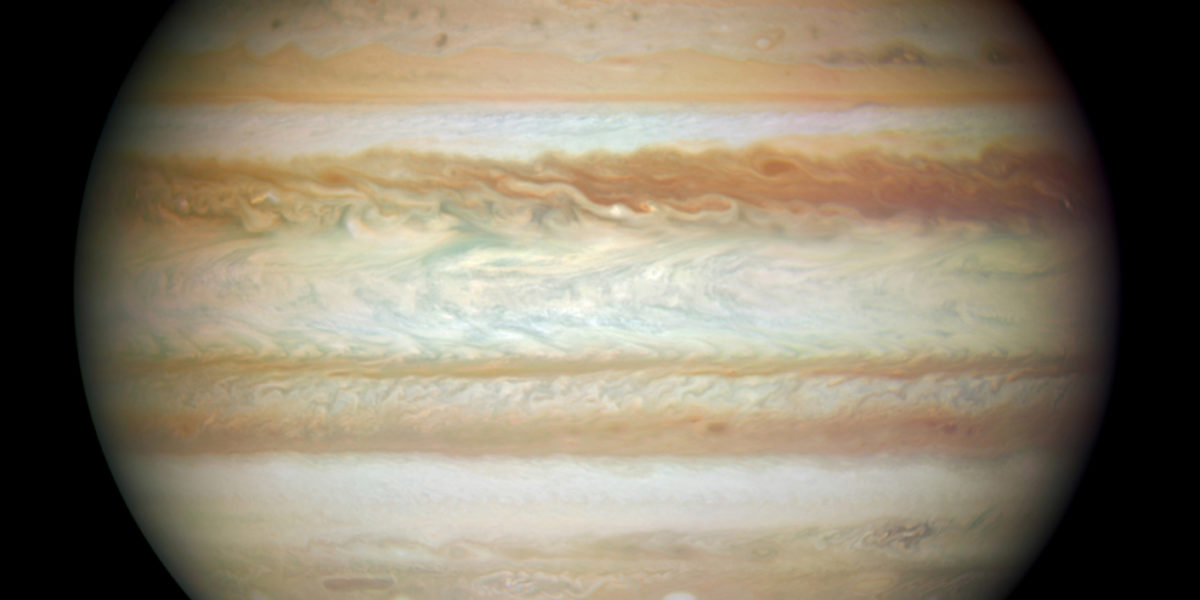
Eyes on Western Skies: Planet Jupiter
Now is a great time to observe the giant gas planet and its ever-changing constellation of moons—one of which is a candidate for extra-terrestrial life. Jupiter is currently closer to Earth than it has been in almost 60 years.

NASA/Handout/Getty Images
From my backyard I can see the Hayward Hills, the steeple of that church near Trader Joe’s, and beyond that, an alien world that may or may not harbor extraterrestrial life.
You can probably guess which one I spend the most time observing.
The celestial body I’m referencing is Europa, one of the many moons of the planet Jupiter. Scientists believe that between the moon’s frozen crust and molten core there is a zone that could theoretically harbor life. What are the chances that it does? Very small, of course, but in our solar system, Europa is said to be a better candidate for life than even sentimental favorite Mars.
This distant and possibly inhabited object may sound like something in the purview of NASA probes at best, or maybe even science fiction, but it isn’t. Europa is very real and easily spotted. From my fairly light-polluted neighborhood in a Bay Area suburb I can see it clearly with a pair of 10X binoculars, a set originally purchased for birding at a cost of no more than $100.
Europa is only one part of what makes the planet Jupiter one of my very favorite elements of the night sky. Jupiter is one of those rare objects that provides a rewarding view at every magnification—or with the naked eye. The Gas Giant is behind only our moon and Venus as the third-brightest object in the night sky.
Binocular View
If you have binoculars look toward Jupiter. With even a modest pair, the stars that happen to be in the same field of view will still appear as points, but Jupiter will reveal itself to be a disk. You should also be able to see several tiny points of light—as many as four—flanking the planet. Those are Jupiter’s largest moons.
I’ve already mentioned Europa; the others are called Io, Callisto, and Ganymede. It may be impossible to tell which one is which by looking with amateur equipment, but there are apps that can help you ID them based on their positions. JupiterMoons is a reliable iOS app. For Android users, try Moons of Jupiter.
If you have a few clear nights in a row, watch the dance those moons perform, pirouetting around the planet in a constantly changing array. With Jupiter, it’s never quite the same view twice.
If You Have a Telescope
If you’re lucky enough to have access to a telescope, you’re in for endless entertainment watching the ever-shifting cloudy surface of the planet. A small telescope will show two strong, orange bands on the surface, while bigger instruments will resolve other, more subtle stripes on the disk.
If you’re really fortunate you might catch a glimpse of the famous Big Red Spot. It’s not always visible, though, even under good conditions. (Sometimes the spot is on the far side of the planet.) The Sky & Telescope website can tell you when the spot will be visible on any given day.
How to Spot Jupiter
Now is a great time to view Jupiter. Right now the Earth is about as close to the planet as it ever gets, so it’s at its biggest and brightest. If fact, Monday, September 26 marks the day the gas giant makes its closest approach to Earth since 1963. Jupiter also happens to be fairly high in the sky right after dark these days, so you don’t need to stay up late or have a perfectly unobstructed view of the horizon. Just look to the east as soon as it’s dark. It will be the brightest thing in that part of the sky and you will probably be able to see it even from an urban center—it’s that bright.
Jupiter appears in the constellation Pisces, and little less than halfway between the horizon and the zenith. Don’t know Pisces? There are an array of apps that can help you find your way across the night sky. I prefer SkyView, which is available for both iOS and Android.
Apps and optics can help you spot Jupiter, but don’t stress if you don’t have access to them. Humans have been observing Jupiter since long before telescopes existed. All you really need is a tolerably dark sky and a view to the Southwest. (And an open-mindedness about the possibility of life on other worlds. That doesn’t hurt, either.)
